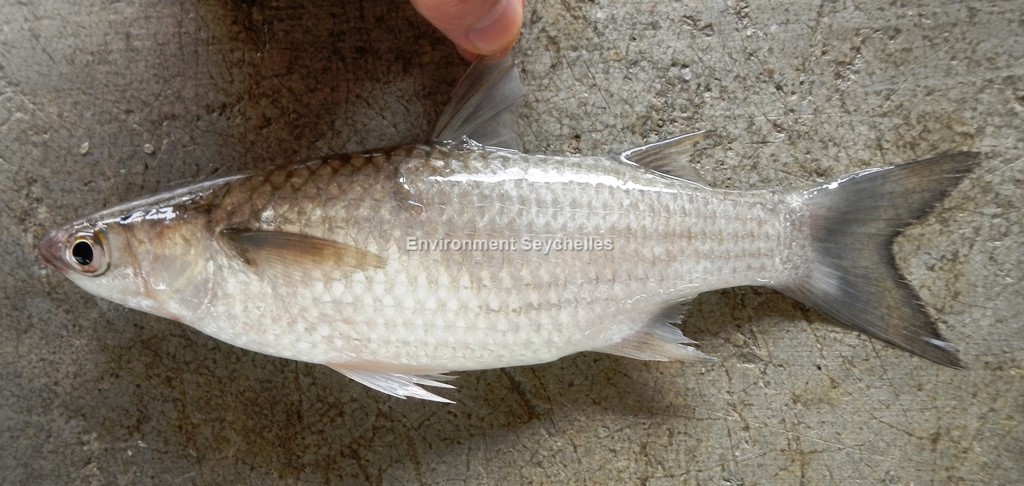Description:
Dorsal spines: 5; Dorsal rays: 7-9; Anal spines: 3; Anal rays: 8-9.
Body elongate, cylindrical/slightly compressed and robust. Head small and without scales, dorsally broad and flat, snout short. Adipose eyelid well
developed, covering most of pupil. Mouth small, terminal and oblique. Thin upper lip, close-set row of slender monocuspid teeth in the edge of lips,
three or four rows of bicuspid teeth in inner side of lips. Posterior edge of upper jaw reaching a vertical line from anterior eye margin. Posterior
nostrils extending above level of upper rim of eye. Lateral line absent. First dorsal fin origin on centre of back. Second dorsal fin opposite and similar
in size and shape to anal fin. Anterior parts and bases of 2nd dorsal and anal fins with a moderately dense coverage of scales. Caudal fin emarginate.
Colour. Variable in colour depending on the habitat. A bluish-grey to olive-brown mullet becoming silvery-white or paler below, with a dark-bluish spot
at the base of the pectoral fin. Scales on back and flanks usually streaked to form longitudinal stripes.
Size:
Maturity: Lm unknown. Range unknown. Max Length: 100 cm SL. Commonly to 50 cm SL.
Habitat and Ecology:
This is a euryhaline, pelagic nearshore species, it sometimes forages in lagoons, estuaries and lower courses of rivers and can tolerate freshwater
(depth 0-120 m, usually 0-10 m). Adults form schools near the surface over sandy or muddy bottoms and dense vegetation and migrate offshore to spawn in
large aggregations. They are mainly diurnal, feeding on detritus, micro-algae and benthic organisms they also graze on epiphytes and epifauna from
seagrasses as well as ingest microalgae from the water’s surface. Individuals become sexually mature at around 32-50 cm in length and around two years
in age.
Fishery Status:
This species is not protected or subject to fishery regulations. It is caught in net fisheries, but is an uncommon component of the catch.
Notes:
Although Mugil cephalus has been thought to occur worldwide, recent molecular studies indicate that is in fact a complex of genetically isolated taxa that
should be treated as distinct species. These species have yet to be elaborated.
References:
Camara, K.D. et al. (2019). Mugil cephalus. The IUCN Red List 2019: http://dx.doi.org/10.2305/IUCN.UK.2019-2.RLTS.T135567A127923853.en. (02/08/19).
Froese, R. & D. Pauly. (Eds.) (2019). FishBase. https://www.fishbase.in/summary/Mugil-cephalus.html (02/08/19).
Gomon, M.F. & Bray, D.J. (2019). Mugil cephalus in Fishes of Australia, http://fishesofaustralia.net.au/home/species/3880 (02/08/19).
Saleh, M.A. (2006). Mugil cephalus. Cultured Aquatic Species Information Programme. In: FAO Fisheries and Aquaculture Department [online]. Rome.
http://www.fao.org/fishery/culturedspecies/Mugil_cephalus/en (02/08/19).
Citation:
Nevill, J.E.G. (2019). Mugil cephalus, Flathead grey mullet. Seychelles Seatizens. www.seatizens.sc. https://seatizens.sc/species/mugil-cephalus-linnaeus-1758/ (edited 06/09/22).




There are no comments